QuestionHi,
We have a 4 year old german shepherd we bought from the pet shop when he was 6 weeks old. He was a playful puppy but was also quiet and acted scared sometimes and would cringe for no reason at all. We live on a farm and he gets heaps of excercise and grew up with 2-3 other dods. (border collie - lab - xstaffie/rottie) he got on with all except sometimes the collie would be dominant as they were both males (he moved to mums 3 years ago) and the lab & cross were females. Anyway, we didn't have any problems with him until a few months ago a boy about 7y/o was playing outside and I heard him scream. I ran out and our dog (Blade) had given a quick bite to the boys face. The boy was holding a screwdriver to him so I don't know if he was actually doing anything to the dog or was just playing with it. (didn't know the boy - that's another long story). A few weeks later our nephew had some friends over so we tied him up in our big tractor shed - where he sleeps. The boys went near him and he did another quick bite to the boy (by quick bite, I mean he only bit once and not repeatedly). Then about a week after that a plumber came and walked upto the house and blade didn't do anything, spoke to my husband then went back to his van to get his tool box and started walking back and Blade started barking and growling and not letting him pass. My husband ran out there and yelled at him and he immediately stopped and didn't worry the plumber again. He was brought up with our son 2y/o, nephew 8y/o, niece 4 y/o, and about 8 adults (very tight & close family....Italians) We really don't want to get rid of him as he is a beautiful dog with a great nature, he's wonderful with our kids and lets them do whatever they want to him - just walks away when he's had enough. He's never been to obedience training but we did do the basic stuff ourselves which he picked up very quickly.
We have heard that getting them fixed may stop them from being aggresive but with small children around I'm a bit worried and would never forgive myself if he did hurt any child or adult again. As I said before, he is a great dog and has never done anything like this before. I don't want to put him down because I really do think that the first boy had frightened him with the screwdriver to make him defend himself and now he's very wary around strange kids. We have thought about the following options, can you please let me know your opinion.
# getting him fixed up and hoping for the best (also keeping a very close eye on him especially around children)
# giving him to my brother in law who lives next door. He really wants him. He doesn't have any children and our place will be fenced soon. That way we can all still see him.
# asking the police force if they want him for training. He is an exceptional guard dog and is very willing to learn new things.
# Give him away to someone else and advise them of these issues.
Thank you in advance and sorry for the really long letter but thought you might need as much info as possible.
Lisa
AnswerBelieve it or not this is a common problem with people who have high energy dogs.
Yes, your wonderful boy is becoming aggressive and this should be nipped in the butt as soon as possible. There are a number of reasons for aggression but the main reason is lack of socialization and boundaries. Dogs need to be taught what to do in various situations. Your dog may behave great around your family but is unsure how to deal with things which strangers come along and appear to be a threat.
I am going to provide you with a copy of a response I recently gave on aggression and strongly recommend working more with your dog in areas that he needs practice. Dogs can overcome any behavior as long as the owner becomes educated on what to do and works with the dog. Owners can see change in the dog in a short period of time so long as the family works together and the family remains consistent and understands better where the dog is coming from.
Getting a dog fixed can help slow your dog down and has been known to help with aggression, however its not an end all fix because he's still in the same environment and still lives by the same rules as before.
It is not recommended that he be provided to the police or given away to a stranger. A stranger may care less about the dog and be less inclined to do the necessary work to help the dog. Too many dogs like this end up in shelters and are millions are put to sleep each year.
Giving your dog to a relative is really up to you, but again, be sure of your reasons why you would give your dog away. Is it because you are not sure what to do. If so You've come to the right place and the help you need is only a question away.
I also provide additional help on my website for aggression and other behavior issues
http://www.gallantshepherds.com/gsdinfo.htm
http://www.gallantshepherds.com/gsdhelp.htm
My Response for dogs showing signs of aggression, providing tips and help:
Your dog is showing signs of aggression for many reasons not just one and if not dealt with it will get worse as your dog gets older. It won't go away on its own. Aggression in dogs comes from Lack of Exercise - Outlet for pent up energy, Lack of Boundaries, Lack of Trust, Confusion, Fear, uncertainty, nervousness, possessiveness or asserting dominance.
It's hard to know what to do if you don't understand where your dog is coming from. With a few changes in the way you relate to your dog, you will see very positive changes in short order. Your Dog is in fight drive aggressive. He wants to protect either himself or you. This is not a good state to stay or live in and it will definitely lead to bigger and bigger problems.
Since you have not stated how you correct your dog I'll need to cover a number of areas. Your dog needs exercise and your dog needs to know the rules in dog speak. Your dog thinks he is the pack leader, and he needs you to be a pack leader he can trust and submit to.
UNDERSTAND YOUR DOG
The first thing you need to know is that dogs are at their happiest when they are in their submissive state. You're dog can't submit when he is in fight or flight drive. Dogs can switch drives and its your job to help him do that. In the wild the pack leader sets the boundaries and the dogs eagerly comply. They know it is in their best interests to do so - their life depends on it. A pack leader immediately and appropriately, corrects inappropriate behavior and ensures that the fogs needs are met.
Dogs live in the present so they don't know what they are in trouble for when they get heck for something they did yesterday or an hour ago. If they are asked to come and they comply only to get into trouble they are afraid to come the next time because when they come they get into trouble. This is one example of how humans are inconsistent and unpredictable with their dogs.
BE A PACK LEADER
A pack leader is not someone that is mean to a dog, gets angry at the dog, yells at the dog, is inconsistent or unpredictable in behaviors. Dogs don't listen to that behavior they defend themselves from it. Dogs also sense anxiety, fear, frustration. A pack leader is confident and relaxed. A pack Leader provides sound structure, is consistent and can be trusted.
BE A PACK LEADER AND CONSISTENTLY WALK YOUR DOG
German Shepherds are high energy dogs. They need an outlet for all that energy. Walking is a must.
In the Wild dogs usually migrate each day looking for food walking mimics what they would naturally do in the wild.
BE A PACK LEADER - TEACH YOUR DOG TO HEEL BY YOUR SIDE.
Teaching a dog to heal is not as hard as most people think. The proper way to walk a dog is to have him walk on your left with a lose lead. Not behind, not pulling (you're the leader not him), not trying to chase other dogs, not barking at people or animals.
A very fast pack leader style to teach your dog. To heel, start by keeping the leash very short. Just long enough to keep him at your side. Consider using a a Halti and or a muzzle, for difficult dogs. A Halti allows you to move his head when you walk, keeping his attention in the right place. Walk tall, shoulders back and walk like you need to go somewhere (until the dog learns to stay by your side).
HOW TO CORRECT A DOG WHILE WALKING ON A LEAD
A dog that is pulling, sniffing, going the other way, barking at people, is aggressive etc. needs to be corrected.
3 Ways to Correct
1. Pull the lead towards you with a short fast jerk. Don't hurt the dog, don't yank so hard to create a neck injury. It is only to get his attention off what he is doing and on to you. And then relax your arm keeping it by your pant pocket. (if you want your dog to relax, you must relax! If you want your dog to be confident in You, be confident yourself!). The goal is to put your dog in a relaxed state of mind. He won't go there if you're not there. Put your thumb in your pocket to get used to where it should be. Hold the access lead in your right hand.
2. Adopt a verbal correction. I say Shhh very fast in an authoritative manner while quickly pulling the lead towards me. Used in a consistent manner my dog's understand what this means. I use this correction off and on lead. Off Lead I point at my dog, look him in the eye, Square off to him in a dominant position and say Shhh. I also gently move the dog to assist him to know what I want at times. I NEVER, YELL AT MY DOGS! I teach by example.
3. If the dog remains stubborn, I gently touch the dog with my foot. If your dog is on your left, use your right foot, bring it behind your left leg to touch the dog. I do not kick the dog or hurt the dog, I simply touch him to get his attention off of what he is doing and on to me. The Goal is to shift from one drive to the other and get is attention on me in order to place him in the relaxed submissive state.
Your dog won't submit if he is afraid. The key is to get him to relax. I teach my dog to sit when I stop. And if stubborn I often stop until I have his complete attention.
The above corrections are designed to take the dog's attention off what he is doing to put his attention on you. The more he is corrected the more he will learn to pay attention to you and the less he will do the undesired behavior. Corrections must ONLY OCCUR AT THE MOMENT THE DOG ACTS. Not 10 minutes later, an hour later and so on. You can prevent pulling or aggressiveness by correcting just as he turns his head to pull or to become aggressive. You can prevent barking by correcting the moment he starts to bark.
CONSISTENCY is the key. Your dog will learn fast.
PRAISE YOUR DOG
Just as important is Praise. When your dog is doing what you want. Say Good Heel! Good Sit!. This gives your dog a word picture he can relate to desired behavior. Pet your Dog. Hug Him. Give him a treat when he is doing what you want.
If he knows you like it he'll continue the behavior. You must be consistent!
BE A PACK LEADER - FIND WAYS TO ENJOY YOUR DOG AND BURN OFF ENERGY
BIKE WITH YOUR DOG
Get an attachment for your bike so you can run your dog without him pulling you over. My dogs love bike rides. It burns off excess energy fast. I love it too, because I can go as fast as them.
RETRIEVE RATHER THAN TUG OF WAR.
Tug of War brings out the dog's aggressiveness. Its a good Idea not to play this with your dog until you have a handle on him. Walk to a field and get your dog to retrieve a ball. All that running is good for your dog and he will love you for it.
BE A GOOD PACK LEADER - SOCIALIZE YOUR DOG
Until a dog has been in a specific situation he does not always respond the way we want. For that reason the Dog needs to be exposed to many different things on a regular basis.
Have your dog sit or lay at your side and practice having friends walk in front of you and around you. Correct your dog immediately as as above for in appropriate behavior. The second your dog turns his head to act inappropriately correct him Don't let him follow through with the behavior. If you allow him to get into fight drive it will be harder to get him under control.
If your dog does not react inappropriately, but allows people to be near, Let your friends come up to him slowly. No Eye contact, hand out. Let him sniff their hand and look at them. Proper dog introductions, are first nose, then Eyes. If he reacts. Either your or someone has invaded his space too quickly and the people need to correct their behavior. If he reacts to a proper introduction, correct him as above. Consider going more slowly with him. If he accepts them. Praise him.
Practice in many situations. Someone at the door. Socialize your dog with children (not a first of course), with bikes, skateboards, busy streets, loud machinery, lawn mowers, blow dryers, blenders, to give him confidence on how to handle the situation.
Teach your dog to pay attention to you on walks and to avoid dogs and distractions. But also teach your dog proper behavior around other dogs and people, socialize him with your neighbors and friends and their dogs.
BE A PACK LEADER WHEN YOU FEED YOUR DOG.
Do NOT leave food out all day for your dog. Do not feed your dog until after his walk in the morning so he feels like he earned it as he would in the wild.
Ask your dog to sit. Do not give him his bowl until he sits and stays.
Put the bowl down and then tell him to go eat.
Leave the food out for 15 minutes. The remove the Bowl. This teaches your dog that Meal Time Is meal time. If he has to miss a few meals, he'll learn to eat when the bowl goes down.
Praise Your Dog For Good Behavior.
PRACTICE LEAVE IT COMMAND (Teaches Self Control. Teaches not to be aggressive around food also)
Practice a Leave It command by placing food on the floor. Hold his collar as he is lying down. When he goes for the food say "Leave It" and hold him back by his collar. When he moves back say Good Dog. Teach him to look at you and wait until you say OK before he gets the treat. Make noise, a clicking sound with your mouth to get his attention at first. I've taught all my dogs this and meal time is a piece of cake...Uh Kibble....
This translates into leaving things he shouldn't get into around the house.... and on walks.
A dog with rules and boundaries, structure, consistency and exercise are a happy dogs. Doing this teaches your dog how you will react too. The more he can anticipate your reaction the more he will want to please you.
Get yourself some good books that help you to understand how a dog thinks and how to train your dog and how to become a pack leader. These are available available on my website.
If you have any further questions or concerns, please check out the info and help sections of my website.
Sincerely
Gallant German Shepherds
http://www.gallantshepherds.com

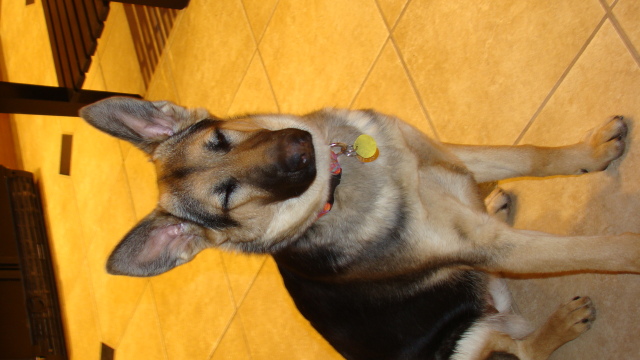 tymber
Question
tymber
ok my gsd is now 7 months old and i hav
tymber
Question
tymber
ok my gsd is now 7 months old and i hav
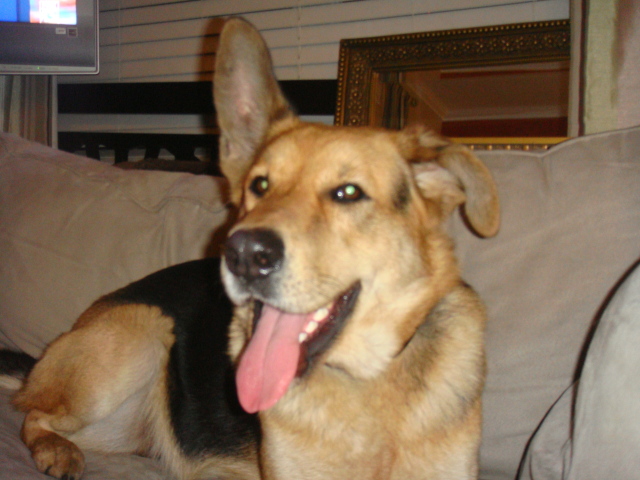 Shepherd ears/teeth
Question
Rosco
We have just taken in a shepherd that we
Shepherd ears/teeth
Question
Rosco
We have just taken in a shepherd that we
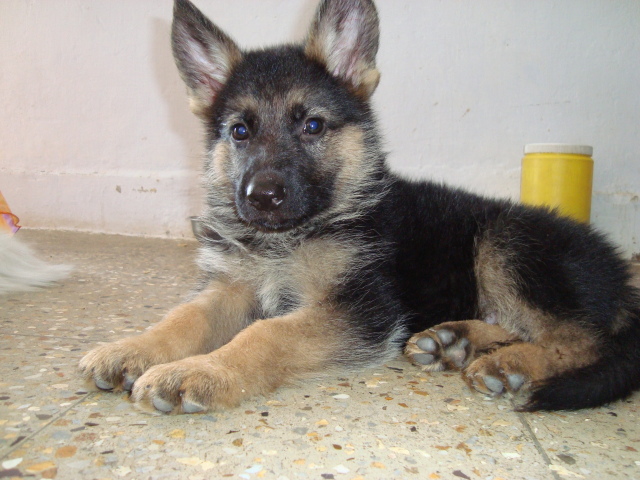 puppy weight
Question
Rocky
I recently purchase 2 mnths old GS puppy
puppy weight
Question
Rocky
I recently purchase 2 mnths old GS puppy
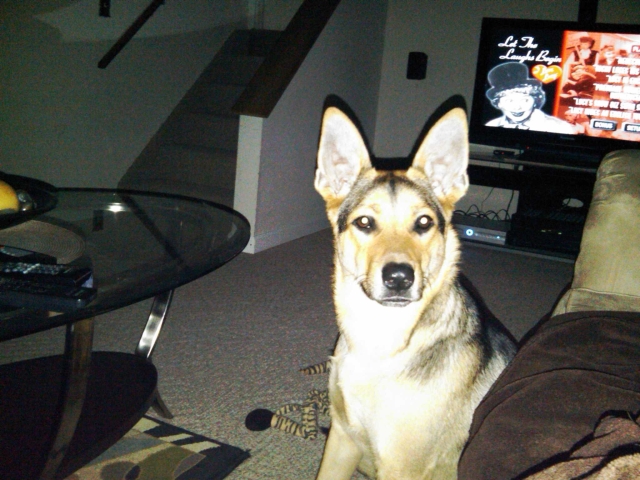 My German Shepherd Acts Scared
Question
Mannie
I have a male 1/2 German Shepherd 1/2 H
My German Shepherd Acts Scared
Question
Mannie
I have a male 1/2 German Shepherd 1/2 H
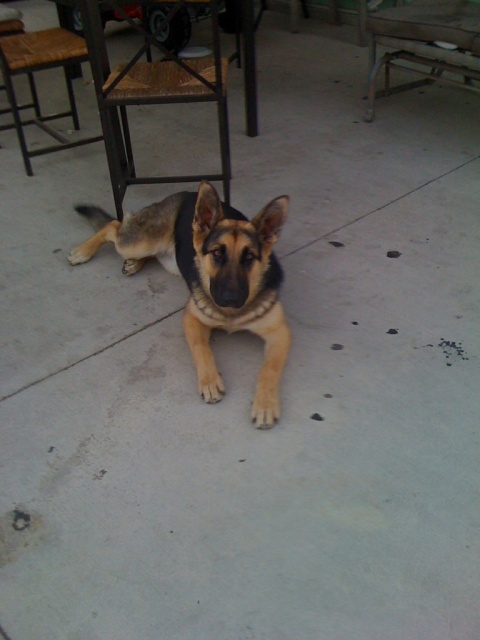 6 month pup
Question6 month old female
QUESTION: I was offer
6 month pup
Question6 month old female
QUESTION: I was offer